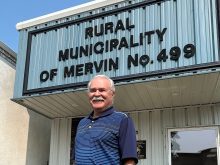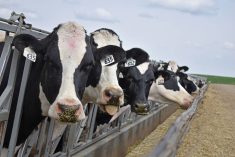O&T Farms is taking Oleet Processing to another level as it doubles manufacturing capacity at its plant near Regina
REGINA — Oleet Processing has announced it will double the capacity of its plant northwest of Regina.
The $10 million expansion is expected to be complete in 2026.
Oleet is an O&T Farms company, which was established in 1967 and well known for its egg and broiler operations. The company sold its quota in the mid-2000s.
Read Also

U.S. bill could keep out Canadian truckers
The Protecting America’s Roads Act, which was tabled in the U.S. House of Representatives at the beginning of October, would “rid the country of illegal immigrant commercial truck drivers and ineligible foreign nationals.”
It makes feed ingredients for animal health and performance, pet food, methane reduction and omega-3 foods for humans.
President Tim Wiens said Oleet has undergone expansions since it opened in 1997, but this will be the first involving new construction. It will include warehouse, office and maintenance space.
The plant originally processed culled laying hens as part of its feed ration, but the odour caused too many problems in the city.
The company switched to flax, pulses and canola and focused heavily on research into better feed ingredients.
“There is increasing demand worldwide for healthy food, especially as it relates to omega-3 fatty acids. We are pioneers and world leaders in producing natural, plant-based omega-3 fatty acids products that help livestock and consumers alike,” says Wiens.
“We see demand increasing, and our market expanding, which is why we are confident in doubling our Saskatchewan manufacturing capacity.”
O&T is the largest flaxseed processor in Canada, purchasing 50,000 tonnes of flax, canola, pulses and alfalfa annually. Saskatchewan farmers grow about 80 per cent of the raw material.
After the expansion, Wiens expects to buy 130,000 tonnes, providing a larger local market along with a consistent, stable and profitable flax market.
“We started with one extruder and got to two pretty quick in that process,” Wiens said.
“Then the next thing you know we’re sitting at around 15 and needing to get more going.”
The plant on Highway 11 has 11 extruders while a smaller mill on Highway 6 north of Regina has the others.
Demand for its patented products is strong.
Wiens cited research at the University of Guelph, and published in Poultry Science in May, that found the company’s linPro, an omega-3, land-based, alpha-linolenic acid (ALA) ingredient, improved the performance of broiler breeder hen progeny. Those offspring had increased body weight, increased breast weight and improved feed conversion ratios.
“We saw the positives and we keep on seeing the positives of having an omega-3 product being eaten by the animals that serve us, whether it’s from egg production to dairy production,” he said.
O&T has also done research at the University of California and University of Florida into the methane reduction properties of flax and the linPRO ingredient.
This week, Wiens was heading to World Dairy Expo for more work on that front.
“We’re getting some omega-3 butter produced in Ontario now and so it’s baby steps, but it’s coming,” he said.
He said there is frustration around supply management in the sense that there would be more benefits if there could be more value added from animal agriculture.
The O&T business has changed significantly in the last 15 years or so since selling first the egg quota and then the broilers.
“I don’t regret being out of supply management and making that decision,” said Wiens.
“We used those monies to consolidate feeding operations and just give ourselves the ability to move forward in the marketplace as an agricultural operation that’s trying out new things.”
Only about two per cent of their products are sold in Saskatchewan, mostly into eggs. The rest go to the United States, Southeast Asia, South America and the Middle East.
Wiens said they have been concentrating on the dairy sector and promoting the omega-3 benefits to producers, processors and retailers, particularly in terms of methane reduction.
“The egg industry really has led the way in showing what can happen, so then it’s just a matter of convincing all of the players that they should pay a little bit more for product because the end result is a value product on the store shelf,” he said.
Staying in Saskatchewan makes sense because the raw product is nearby. The company ships in bulk rail cars and uses 15 transloading sites in the U.S. to get the ingredient to the production sites.
Product also moves to Eastern Canada by rail, and Wiens said sales are growing.
He added research has shown that feeding three or four pounds of linPRO daily to a dairy cow is beneficial. That means 100,000 cows would need about 400,000 pounds, or 200 tonnes.
“You’ve got to have a lot of infrastructure to make sure that happens, and that 100,000 is just one percent of the North American market,” Wiens said.
O&T’s product is still under patent, and he agreed there are other ways to get omega-3s into animals.
“But we still think that we’re the best at it, and our product and process is the best,” he said.
“Competition is usually a good thing, so eventually if somebody devises a better mouse trap, we’ll just have to try to figure out how we can buy it from them.”
The expansion will create more than 20 new jobs and triple the company’s economic activity.
The company currently sustains 262 jobs and has more than $55 million in yearly sales. That generates $133.5 million in economic activity and nearly $10 million in government revenue, it said.


















